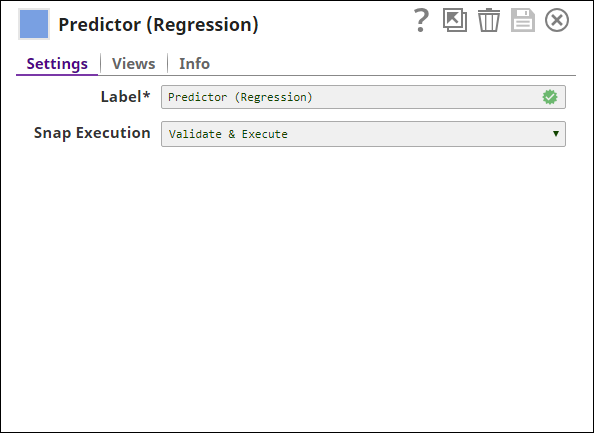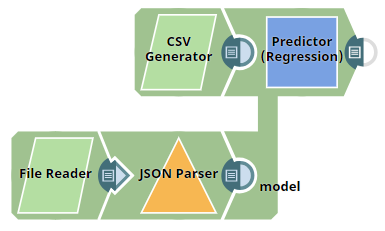On this Page
| Table of Contents | ||||
|---|---|---|---|---|
|
Overview
Expected Input and Output
Prerequisites
Configuring Accounts
Accounts are not used with this Snap.
OR
This Snap uses account references created on the Accounts page of SnapLogic Manager to handle access to this endpoint. See <link to Snap Pack's account page> for information on setting up this type of accountThis is a Transform type Snap that enables you to predict the target field for an unlabeled document. An unlabeled document is one that does not have a label field. So, the Snap reads this unlabeled document and predicts the target field. Predictions are made based on the regression model built by the Trainer (Regression) Snap.
Input and Output
Expected input: An unlabeled document and the regression model.
Expected output: Predictions from the regression model based on the input document.
Expected upstream Snaps:
- First input view: Any Snap that generates an unlabeled document document. For example, JSON Parser, JSON Generator, CSV Parser, CSV Generator, Mapper, and so on.
- Second input view: Any Snap that reads and outputs the regression model. For example, a combination of File Reader, and JSON Parser.
Expected downstream Snaps: Any Snap that uses the predicted result. For example, Aggregate, or a combination of File Writer and JSON Formatter.
Prerequisites
The input document must be in tabular format (no nested structure).
Configuring Accounts
Accounts are not used with this Snap.
Configuring Views
Input | This Snap has exactly one document input view.two document input views. The first input view is for the unlabeled document that requires prediction. The second input view is for the regression model. |
|---|---|
| Output | This Snap has exactly one document output view. |
| Error | This Snap has at most one document error view. |
Troubleshooting
None.
Limitations and Known Issues
None.
Modes
- Ultra pipelinesPipelines: Does not work in Ultra pipelines.Spark mode: Does not work in Spark modeWorks in Ultra Pipelines.
Snap Settings
Downloads
| Label | Required. The name for the Snap. Modify this to be more specific, especially if there are more than one of the same Snap in the pipeline. | |
|---|---|---|
| Info | ||
| ||
| Execute during preview | Select this property to execute the Snap when the pipeline is validated. Default value: Not selected |
Examples
Snap Execution | Select one of the following three modes in which the Snap executes:
Default Value: Execute only |
Examples
Heating Load Prediction – Testing
The model trained in the Heating Load Prediction – Model Training example pipeline is tested against an unlabeled dataset.
Download this pipeline.
| Note |
|---|
To understand the dataset and the process prior to testing the model see the following examples: |
| Expand | ||
|---|---|---|
| ||
In this example, the unlabeled dataset is created using the CSV Generator Snap. This dataset is used as the data input for the Predictor (Regression) Snap. The target field (heating load) is to be predicted for this dataset. The model trained in the Heating Load Prediction – Model Training example is used as the model input. The File Reader Snap is configured to read this model from the SLDB. The JSON Parser Snap is used to parse the output from the File Reader Snap. Below is a preview of the output from the JSON Parser Snap (the model): Model TestingTo test a model trained on a classification dataset, the Predictor (Regression) Snap must be used. The Predictor (Regression) Snap requires two inputs:
The Predictor Snap is configured as shown below: Based on its configuration, the output from the Snap includes one class prediction per document. This output is as shown below: Download this pipeline. |
Additional Example
The following use case demonstrates a real-world scenario for using this Snap:
Downloads
| Multiexcerpt include macro | ||||
|---|---|---|---|---|
|
| Attachments | ||
|---|---|---|
|
Additional Resources
Snap History
| Insert excerpt | ||||||
|---|---|---|---|---|---|---|
|




